

 |
Run by book lovers, for book lovers
See also Sedgley's Men of Iron; Dud Dudley and Abraham Darby – Keeping it in the Family
 The world's first Iron Bridge near Coalbrookdale in Shropshire |
Abraham Darby (the Grandfather of the famous bridge builder) was born in 1678 at Wrens Nest in the hamlet of Woodsetton in the Parish of Sedgley, Staffordshire, son of John & Ann Darby.
(His birthplace is often incorrectly given as Dudley in Worcestershire) He died on 8th March 1717, Madeley Court, Shropshire |
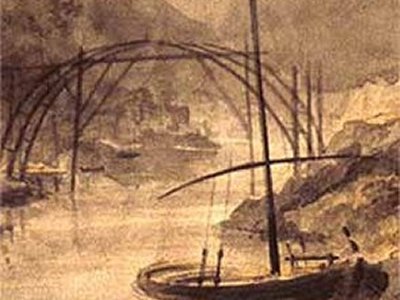 A watercolour of the Iron Bridge under construction in 1779 by Elias Martin.
|
The first of a succession of iron manufacturers who bore the same name, he was the son of a Quaker (Society of Friends) farmer residing at Wrens Nest, near Sedgley and served his apprenticeship with a maker of malt-kilns near Birmingham, Later he married and moved to Bristol around 1700, to begin business on his own.
In Bristol he was joined by three partners of the same Quaker persuasion, who provided the necessary capital to enable him to set up works at Baptist Mills, near the city. He carried on the business of malt-mill making and later added brass and iron founding He acquired premises at Coalbrookdale, on the River Severn in Shropshire, close to supplies of low-sulphur coal. In 1709 he produced marketable iron in a coke-fired furnace. He demonstrated the superiority of coke in cost and efficiency by building much larger furnaces than were possible using charcoal as a fuel, the latter being too weak to support a heavy charge of iron. The quality of Darby's iron made it possible for him to manufacture thin castings that could compete successfully with brass in such applications as the manufacture of pots and other hollow ware.
|
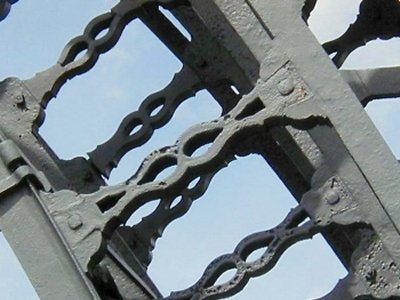 Close-up of bridge joints. |
The advent of the Thomas Newcomen steam engine in 1712 created an important new market for iron and by 1758, when Darby had been succeeded by his eldest son, also named Abraham (1711-63), more than 100 Newcomen cylinders had been cast at Coalbrookdale.
In 1779 Darby's grandson, Abraham Darby III (1750-91), completed the world's first cast-iron bridge (at present-day Ironbridge, near Coalbrookdale.) The bridge's semicircular arch spans 100.5 feet (30.6 m) and has five arch ribs, each cast in two halves. Thomas Farnolls Pritchard (1723-1777) of Shrewsbury was the designer of the bridge. Because they had little knowledge of connecting cast-iron pieces together they used the typical woodworking dovetail jointing method of the era (see left) In 1802 the Coalbrookdale Works built the first railway locomotive with a high-pressure boiler, for Richard Trevithick, the English engineer and inventor. |
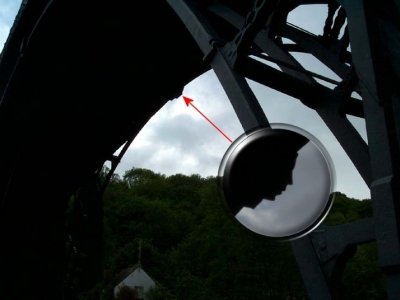
|
If you're looking for a picture of Abraham Darby or his family I'm afraid you probably won't find one because their Quaker religion discouraged images of people.
But... Due to some quirk of fate there appears to be a silhouette of a face on centre joint of the bridge (see left) or... did Abraham create it on purpose? |
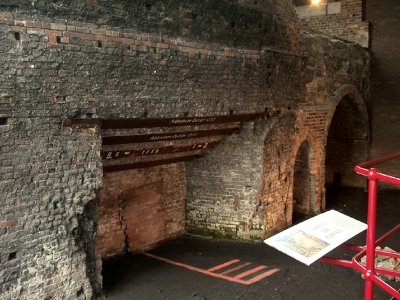
|
Abraham's Iron smelting furnace in Coalbrookdale |
|
|
The headstones of Abraham Darby II |
 |
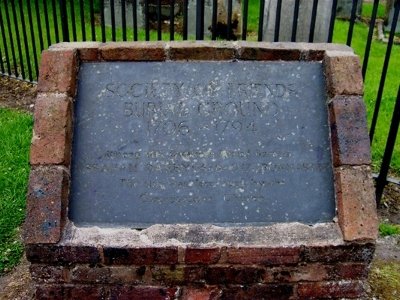 |
| The first Abraham Darby was buried in Broseley in 1717. | Inscription reads : Society of Friends Burial Grounds 1706 - 1794 Amongst those buried here is Abraham Darby 1678 - 1717 Ironmaster The site was never used by the Congregational Church |
There is some controversy over his burial location as some locals claim the graveyard where he was buried was at another chapel just down the road from here. It was later turned into a cinema and all the graves were moved to this one pictured.
Abraham Darby I lived in Broseley Hall for a while. Plans to build the Iron Bridge were actually made at a meeting of local business people and bigwigs held in the annexe to what is now The Cumberland Hotel. A subscription list to fund the bridge was set up with 15 contributors - so in actual fact the bridge was funded by Broseley folk!!
Thomas Farnolls Pritchard, the Shrewsbury architect who designed the bridge, also did a lot of other work in Broseley. Broseley Hall contains five Pritchard chimneypieces and the formal lawns of the garden lead down to Pritchard Temple. He also did work at "The Lawns", Broseley, home of the ironmaster John Wilkinson.
Ironbridge Halfpenny
 |
|---|
|
Coalbrook Dale (Shropshire) copper halfpenny token dated 1792. Detailed view of the bridge with a sailing ship passing underneath: Inscription reads : "IRON BRIDGE AT COALBROOK DALE. 1792", "ERECTED ANNO 1779. SPAN 100 FEET" |
| Many thanks to Geoff Barnett of Shropshire and Irene Harris for the excellent photographs and much of the information on this page. |
| Search the whole Sedgley site |